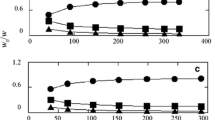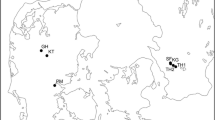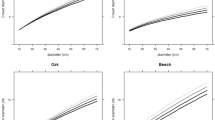Abstract
We investigate the characteristics of individual tree response to competition on source–sink balance through the functional–structural plant model GreenLab. Four Chinese pine (Pinus tabulaeformis Carr.) trees were destructively sampled and were divided into two groups: high-density group and low-density group. First, the effects of density on organ dimensions and on organ relative mass were analysed based on experimental measurements. These were primary indicators of the plant response to competition. Second, the hidden parameters of the GreenLab model, as well as a tree-specific characteristic surface, were estimated using the data of total tree biomass for needle and wood compartments, for each of the four trees in parallel. The quality of the fitting is finally validated using data of individual organ mass at shoot level for the sampled branches. The Mann–Whitney Student’s t test showed that there were significant differences between the shoot attributes of the two groups for shoot diameter, shoot biomass and needle biomass. No significant difference was found for current year shoot lengths of the two groups. The parametric identification of the model allowed estimating and comparing the amount of biomass that was allocated to primary growth and to secondary growth in the two density conditions. It showed that biomass allocated to secondary growth (ring compartment) was the most strongly affected by density, and that the organ demand satisfaction ratio profiles of each of these trees were a relevant, integrated indicator of the tree state.










Similar content being viewed by others
References
Assmann E, Franz F (1965) Vorläufige Fichten-Ertragstafel für Bayern Forstwissenschaftliches Centralblatt 84 (1/2), Sonderdruck. Verlag Paul Parey, Hamburg and Berlin, pp 1–68
Baskerville GL (1965) Estimation of dry weight of tree components and total standing crop in conifer stands. Ecology 46:867–869
Bella IE (1971) A new competition model for individual trees. For Sci 17:364–372
Brown GS (1965) Point density in stems per acre. New Zealand For Res Notes 38:1–11
Corral RJ, Alvarez Gonzalez J, Oscar A, Hernandez FJ (2005) The effect of competition on individual tree basal area growth in mature stands of Pinus cooperi blanco in Durango (Mexico). Eur J Forest Res 124:133–142
Cournède PH, Kang MZ, Mathieu A, Barczi JF, Yan HP, Hu BG, de Reffye P (2006) Structural factorization of plants to compute their functional and architectural growth. Simulation 82(7):427–438
Cournède PH, Mathieu A, Houllier F, Barthèlèmy D, de Reffye P (2008) Computing competition for light in the GREENLAB model of plant growth: a contribution to the study of the effects of density on resource acquisition and architectural development. Ann Bot 101(8):1207–1219
Cournède PH, Letort V, Mathieu A, Kang MZ, Lemaire S, Trevezas S, Houllier F, de Reffye P (2011) Some parameter estimation issues in functional-structural plant modelling. Math Model Nat Phenom 6(2):133–159
de Reffye P, Fourcaud T, Blaise F, Barthèlèmy D, Houllier F (1997) A functional model of tree growth and tree architecture. Silva Fennica 31:297–311
de Reffye P, Heuvelink E, Barthélémy D, Cournède PH (2008) Plant growth models. In: Jorgensen SE, Bath B (eds) Ecological models. Vol. 4 of encyclopedia of ecology (5 vol). Elsevier, Oxford, pp 2824–2837
Deleuze C (1996) Pour une dendrométrie fonctionnelle: essai sur l’intégration de connaissances écophysiologiques dans les modèles de production ligneuse. PhD thesis, Université Claude Bernard—Lyon I
Guo H, Letort V, Hong LX, Fourcaud T, Cournède PH, Lu YC, de Reffye P (2006a) In: Second international symposium on plant growth modeling and application, 2006. PMA'06, IEEE, Beijing, pp 236–243
Guo Y, Ma YT, Zhan ZG, Li BG, Dingkuhn M, Luquet D, de Reffye P (2006b) Parameter optimization and field validation for the functional-structural model GREENLAB for maize. Ann Bot 97:217–230
Guo H, Lei XD, Letort V, Lu YC, de Reffye P (2009) A Functional-structural model GreenLab for Pinus Tabulaeformis. Chinese J Plant Ecol 33(5):950–957
Hegyi G (1974) A simulation model for managing jack-pine stands. In: Fries J (ed) Growth models for tree and stand simulation. Royal College of Forestry, Sweden, pp 74–90
Kang MZ, Cournède PH, de Reffye P, Auclair D, Hu BG (2008) Analytical study of a stochastic plant growth model: application to the GreenLab model. Math Comp Simul 78(1):57–75
Lanner RM (1985) On the insensitivity of height growth to spacing. For Ecol Manag 13:143–148
Letort V, Cournède PH, Mathieu A, de Reffye P, Constant T (2008) Parametric identification of a functional-structural tree growth model and application to beech trees (Fagus sylvatica). Funct Plant Biol 35:951–963
Mathieu A, Cournède PH, Letort V, Barthélémy D, de Reffye P (2009) A dynamic model of plant growth with interactions between development and functional mechanisms to study plant structural plasticity related to trophic competition. Ann Bot 103(8):1173–1186
Mitchell KJ (1975) Dynamics and simulated yield of Douglas-fir. For Sci Monogr 21(4):1–39
Pacala SW, Charles DC, John S, John AS, Richard KK, Eric R (1996) Forest models defined by field measurements: estimation, error analysis and dynamics. Ecol Monogr 66:1–43
Prusinkiewicz P (2004) Modeling plant growth and development. Curr Opin Plant Biol 7:79–83
R Development Core Team (2008) R: a language and environment for statistical computing. R Foundation for Statistical Computing, Vienna, Austria. ISBN 3-900051-07-0, URL: http://www.R-project.org
Reader RJ, Wilson SD, Belcher JW, Wisheu I, Keddy PA, Tilman D (1994) Plant competition in relation to neighbor biomass: an intercontinental study with Poapratensis. Ecology 75:1753–1760
Shinozaki K, Yoda K, Hozumi K, Kira T (1964) A quantitative analysis of plant form—the pipe model theory. I Basic analysis. Jpn J Ecol 14:97–105
Sievänen R, Nikinmaa E, Nygren P, Ozier-Lafontaine H, Perttunen L, Hakula H (2000) Components of functional-structural tree models. Annals For Sci 57:399–412
Sievänen R, Perttunen J, Nikinmaa E, Kaitaniemi (2008) Toward extension of a single tree functional–structural model of Scots pine to stand level: effect of the canopy of randomly distributed, identical trees on development of tree structure. Funct Plant Biol 35(9/10):964–975
Sjolte-Jorgensen J (1967) The influence of spacing on the growth and development of coniferous plantations. Int Rev For Res 2:43–94
Smith D (1962) The practice of silviculture. Wiley, New York
Staebler GR (1951) Growth and spacing in even-aged stand of Douglas-fir. MS Thesis, University of Michigan, MI, 46
Stoll P, Weiner J (2000) A neighborhood view of interactions among individual plants. In: Dieckmann U, Law R, Metz JAJ (eds) The Geometry of Ecological Interactions: simplifying spatial complexity. Cambridge University Press, Cambridge, pp 11–27
Tilman D (1982) Resource competition and community structure. Princeton University Press, Princeton
Tilman D (1990) Mechanisms of plant competition for nutrients the elements of a predictive theory of competition. In: Grace JB, Tilman D (eds) Perspectives on plant competition. Academic Press, New York, pp 117–141
Vos J (1995) The effects of nitrogen supply and stem density on leaf attributes and stem branching in potato (Solanum tuberosum L.). Potato Research 38(3):278–279
Vos J, Marcelis L, de Visser P, Struik P, Evers J (2007) Functional–structural plant modelling in crop production. Springer, Berlin
Wang F, Kang MZ, Lu Q, Letort V, Han H, Guo Y, de Reffye P, Li BG (2011) A stochastic model of tree architecture and biomass partitioning: application to Mongolian Scots pines. Ann Bot 107:781–792
Wu LY, Zhou Q, Wang JB, Wu GS, Wang ZQ (2000) Effects of competition on growth of Amur linden plantation. J For Res 11(2):95–98
Yan HP, Kang MZ, de Reffye P, Dingkuhn M (2004) A dynamic, architectural plant model simulating resource-dependent growth. Ann Bot 93:591–602
Yang D, Yang XQ (2004) Studies on biomass and productivity of Pinus tabulaeformis plantation in the Wufengshang of Wudu, Gansu Province. J Northwest Norm Univ Nat Sci 40(1):70–73
Zhan ZG, de Reffye P, Houllier F, Hu BG (2003) Fitting a structural–functional model with plant architectural data. In: Hu BG, Jaeger M (eds) Plant growth modeling and applications (PMA03). Tsinghua University Press/Springer, Beijing, pp 236–249
Zhao X, de Reffye P, Xiong FL, Hu Bg, Kang MZ (2003) Dual scale automata modeling based simulation of plant anthotaxy. J Comput 26(1):116–124
Acknowledgments
We are grateful to Philippe de Reffye from CIRAD, Montpellier, France for giving helpful advice, and Diao Jun, Rong Jiantao, Liu Xianzhao from Chinese Academy of Forestry (CAF) for their contributions to field observations. The study was supported by Natural Science Foundation of China (No.: 30872022; 31100474) and Zhejiang Tengtou Landscape Co. LTD.
Author information
Authors and Affiliations
Corresponding authors
Additional information
Communicated by R. Matyssek.
Rights and permissions
About this article
Cite this article
Guo, H., Lei, X., Cournede, PH. et al. Characterization of the effects of inter-tree competition on source–sink balance in Chinese pine trees with the GreenLab model. Trees 26, 1057–1067 (2012). https://doi.org/10.1007/s00468-012-0683-x
Received:
Revised:
Accepted:
Published:
Issue Date:
DOI: https://doi.org/10.1007/s00468-012-0683-x




